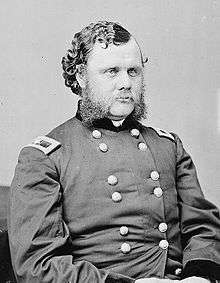Robert O. Tyler
| Robert O. Tyler | |
|---|---|
 Robert O. Tyler | |
| Born |
December 31, 1831 Hunter, New York |
| Died |
December 1, 1874 (aged 42) Boston, Massachusetts |
| Place of burial | Cedar Hill Cemetery, Hartford, Connecticut |
| Allegiance |
United States of America Union |
| Service/branch |
United States Army Union Army |
| Years of service | 1853–1874 |
| Rank |
|
| Unit | Army of the Potomac |
| Commands held |
Artillery Reserve; Fourth Division, II Corps |
| Battles/wars | |
| Other work | author |
Robert Ogden Tyler (December 31, 1831 – December 1, 1874) was an American soldier who served as a general in the Union Army during the American Civil War. He is best known as the commander of the Artillery Reserve of the Army of the Potomac, including at the Battle of Gettysburg in July 1863, where many of his batteries played important role in the Union victory. Tyler later led a division of heavy artillery turned infantry during the Overland Campaign of 1864, when he was badly wounded and relegated to administrative duties for the duration of the war.
Early life and career
Tyler was born in the tiny hamlet of Hunter, New York, to Frederick and Sophia (née Sharp) Tyler. He was a nephew of Daniel Tyler, who also would serve as a general in the Civil War. He received an appointment to the United States Military Academy in West Point, New York, and graduated 22nd of 52 cadets in the Class of 1853.[1] He received a brevet appointment as a second lieutenant and was assigned to the artillery. He subsequently served in a variety of posts throughout the country.
Tyler served as an artilleryman in the Utah Territory during the Mormon disputes and was among the U.S. Army officers who signed a petition supporting the reappointment of the controversial Mormon leader Brigham Young as governor.[2]
Civil War
During the April 1861 crisis at Fort Sumter in Charleston, South Carolina, Tyler was part of a hastily assembled relief force that tried unsuccessfully to reinforce the beleaguered garrison. That September, he was appointed as the colonel of the 4th Connecticut Infantry. Tyler began training the men as artillerymen, and the regiment was eventually renamed the 1st Connecticut Heavy Artillery.
The regiment served in the Peninsula Campaign, and Tyler commanded the siege train of the Army of the Potomac under Maj. Gen. George B. McClellan. On November 29, 1862, Tyler was promoted to brigadier general of volunteers and assigned command of all the artillery in the "Center Grand Division" of the army. His guns participated in the Battle of Fredericksburg, providing artillery support for the series of assaults on Confederate positions on the heights near Fredericksburg.
Maj. Gen. Joseph Hooker assumed command of the Army of the Potomac and reorganized it, creating a formal Artillery Reserve under Tyler's command. Tyler commanded the reserve during the battles of Chancellorsville and Gettysburg, where many of his guns were used to help repel Confederate attacks on such Union positions as Cemetery Ridge and Cemetery Hill, as well as during Pickett's Charge on July 3. (Tyler was disabled by sun stroke during part of the Gettysburg campaign.) Tyler also participated in the autumn Bristoe and Mine Run campaigns, but played no major role.
In early 1864, Tyler was assigned command of a division of infantry consisting entirely of heavy artillery regiments, which he led at Harris Farm in the Battle of Spotsylvania Court House, where it was attached to II Corps. He then led a brigade in 2nd Division, II Corps, at the Battle of Cold Harbor. In the latter battle, Tyler was badly wounded in his foot, which incapacitated him from any further field duty during the war. After recovery, Tyler served in a variety of administrative posts.
Postbellum career
At the close of the war, the War Department rewarded scores of officers with brevet promotions dating from March 1865. Tyler received the brevet rank of major general of volunteers for "great gallantry at the Battle of Cold Harbor". In 1866 he mustered out of volunteer service and was commissioned as a lieutenant colonel in the regular army, serving as deputy Quartermaster General.
His wartime injuries contributed to his declining health, and Tyler died in Boston, Massachusetts, at the age of 42. He is buried in Cedar Hill Cemetery in Hartford.[1] Before he died, he was able to complete his autobiography, the Memoir of Brevet Major-General Robert Ogden Tyler (Philadelphia: J.B. Lippincott, 1878).
The Robert O. Tyler Post #50 of the Grand Army of the Republic in Hartford was named in his honor.[3]
See also
Notes
- 1 2 Eicher & Eicher 2001, p. 539
- ↑ Hyde 1857, p. 149
- ↑ Listing of GAR posts in Connecticut
References
- Eicher, John H.; Eicher, David J. (2001). Civil War High Commands. Stanford, CA: Stanford University Press. ISBN 0-8047-3641-3.
- Hyde, John (1857). Mormonism: Its Leaders and Designs. New York: W. P. Fetridge and Company. OCLC 414648.
External links
- Monument to Tyler and the Artillery Reserve at Gettysburg National Military Park
- Artillery Reserve marker in Frederick County, Maryland
- "Robert O. Tyler". Find a Grave. Retrieved August 16, 2010.